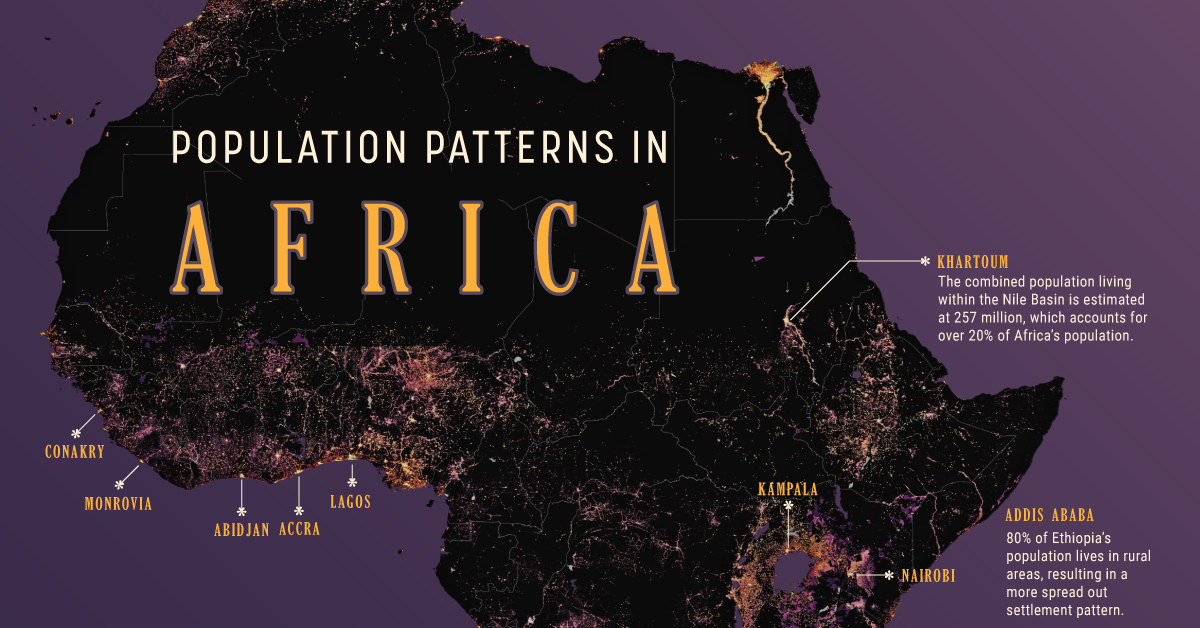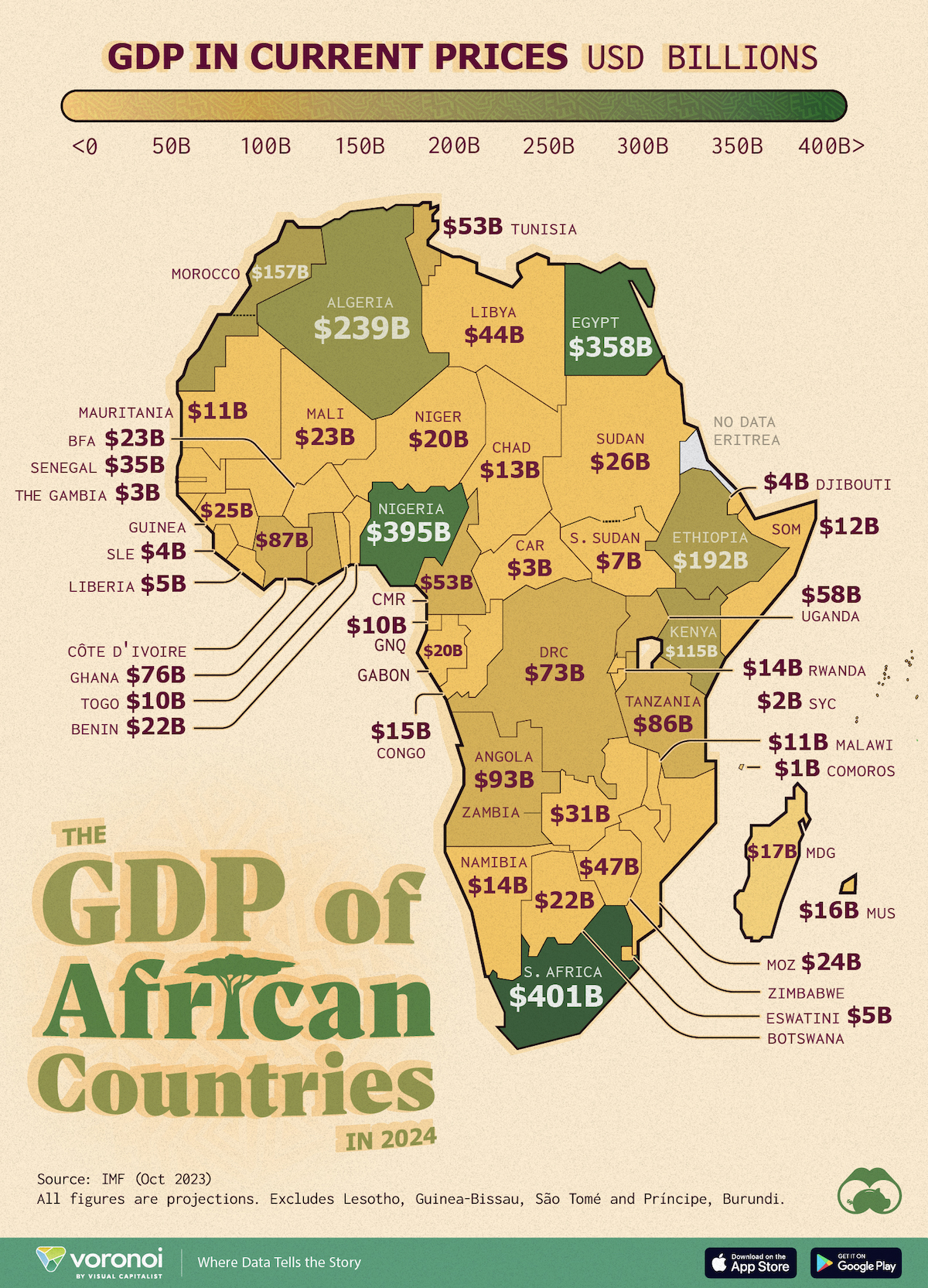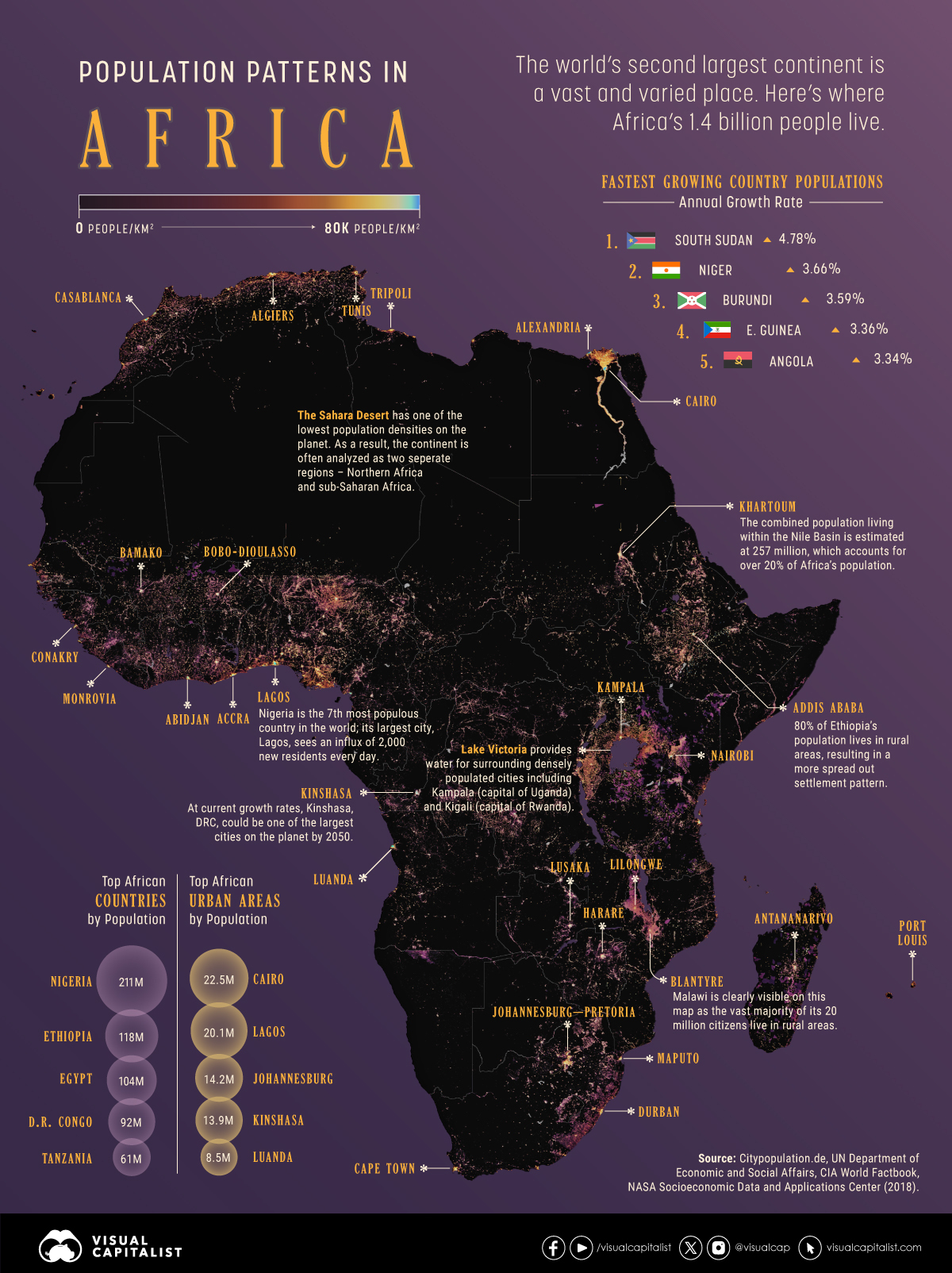Africa
Mapped: Breaking Down the $3 Trillion African Economy by Country
![]() See this visualization first on the Voronoi app.
See this visualization first on the Voronoi app.
Breaking Down the $3 Trillion African Economy by Country
This was originally posted on our Voronoi app. Download the app for free on iOS or Android and discover incredible data-driven charts from a variety of trusted sources.
Home to 1.4 billion people, the nations of the African continent are widely diverse; not just in culture and language, but also in economic output.
We visualize the 2024 gross domestic product (GDP) projections for African countries from International Monetary Fund (IMF) estimates, last updated in October 2023. The data is in current USD, and does not include projections for Eritrea.
Furthermore, data for Lesotho, Guinea-Bissau, São Tomé and Príncipe, and Burundi has been left off the map due to a lack of space but has been included in the article’s table.
Ranked: Africa’s Economies by GDP
At first place, South Africa is Africa’s biggest economy in nominal terms, with an estimated GDP of nearly $400 billion.
The country’s mining industry is a major contributor to the economy, accounting for nearly 60% of total exports in the first half of 2023. South Africa is one of the world’s biggest producers of gold, diamonds, platinum, manganese, and other minerals.
However, concerns regarding the sustainability of South Africa’s mining industry have grown since the pandemic. According to a report by PwC, the country’s gold industry may have less than 30 years left without renewed investment.
| Rank | Country | GDP |
|---|---|---|
| 1 | 🇿🇦 South Africa | $401B |
| 2 | 🇳🇬 Nigeria | $395B |
| 3 | 🇪🇬 Egypt | $358B |
| 4 | 🇩🇿 Algeria | $239B |
| 5 | 🇪🇹 Ethiopia | $192B |
| 6 | 🇲🇦 Morocco | $157B |
| 7 | 🇰🇪 Kenya | $115B |
| 8 | 🇦🇴 Angola | $93B |
| 9 | 🇨🇮 Côte d'Ivoire | $87B |
| 10 | 🇹🇿 Tanzania | $86B |
| 11 | 🇬🇭 Ghana | $76B |
| 12 | 🇨🇩 DRC | $73B |
| 13 | 🇺🇬 Uganda | $58B |
| 14 | 🇹🇳 Tunisia | $53B |
| 15 | 🇨🇲 Cameroon | $53B |
| 16 | 🇿🇼 Zimbabwe | $47B |
| 17 | 🇱🇾 Libya | $44B |
| 18 | 🇸🇳 Senegal | $35B |
| 19 | 🇿🇲 Zambia | $31B |
| 20 | 🇸🇩 Sudan | $26B |
| 21 | 🇬🇳 Guinea | $25B |
| 22 | 🇲🇿 Mozambique | $24B |
| 23 | 🇲🇱 Mali | $23B |
| 24 | 🇧🇫 Burkina Faso | $23B |
| 25 | 🇧🇼 Botswana | $22B |
| 26 | 🇧🇯 Benin | $22B |
| 27 | 🇬🇦 Gabon | $20B |
| 28 | 🇳🇪 Niger | $20B |
| 29 | 🇲🇬 Madagascar | $17B |
| 30 | 🇲🇺 Mauritius | $16B |
| 31 | 🇨🇬 Congo | $15B |
| 32 | 🇷🇼 Rwanda | $14B |
| 33 | 🇳🇦 Namibia | $14B |
| 34 | 🇹🇩 Chad | $13B |
| 35 | 🇸🇴 Somalia | $12B |
| 36 | 🇲🇼 Malawi | $11B |
| 37 | 🇲🇷 Mauritania | $11B |
| 38 | 🇬🇶 Equatorial Guinea | $10B |
| 39 | 🇹🇬 Togo | $10B |
| 40 | 🇸🇸 South Sudan | $7B |
| 41 | 🇸🇿 Eswatini | $5B |
| 42 | 🇱🇷 Liberia | $5B |
| 43 | 🇩🇯 Djibouti | $4B |
| 44 | 🇸🇱 Sierra Leone | $4B |
| 45 | 🇧🇮 Burundi | $3B |
| 46 | 🇨🇫 Central African Republic | $3B |
| 47 | 🇨🇻 Cabo Verde | $3B |
| 48 | 🇬🇲 Gambia, The | $3B |
| 49 | 🇱🇸 Lesotho | $3B |
| 50 | 🇬🇼 Guinea-Bissau | $2B |
| 51 | 🇸🇨 Seychelles | $2B |
| 52 | 🇰🇲 Comoros | $1B |
| 53 | 🇸🇹 São Tomé and Príncipe | $1B |
| Total | $2,987B |
Note: Figures are rounded.
Close behind South Africa, Nigeria’s economic output in 2024 is estimated at $395 billion. Declining oil production—the country’s main export—along with foreign exchange woes, have made for a broader economic crisis, sparking protests. Inflation is also running rampant in the economy as well: expected to peak at 33% by mid-2024.
Africa’s third-largest economy, Egypt, is also suffering from extremely high inflation since the beginning of the Russia-Ukraine conflict. This is largely due to the country’s reliance on food imports from those nations. According to the IMF, core inflation in Egypt hit nearly 40% in 2023, while food inflation briefly surpassed 70%.
Oil plays a huge role in fourth-ranked Algeria as well, contributing nearly 25% to the country’s $239 billion economic output.
However, in fifth-ranked Ethiopia, agriculture accounts for more than 40% of the country’s $192 billion GDP and coffee is its biggest export. Gold and gemstone mining are seen as an important areas of diversification for the country’s economy.
Countries
Mapped: Africa’s Population Density Patterns
We map out Africa’s population density, spotlighting the continent’s most populous countries and cities.

Mapped: Africa’s Population Density Patterns
This was originally posted on our Voronoi app. Download the app for free on iOS or Android and discover incredible data-driven charts from a variety of trusted sources.
Africa, the world’s second largest continent, spans over 30 million km2, home to the not only world’s biggest desert but also the second-largest tropical rainforest, and of course, approximately 1.4 billion people.
In this infographic, we map out the continent’s population density patterns. It’s a prime example of how humans congregate near fresh water and around the edges of natural obstacles.
This population density data comes from the Gridded Population of the World dataset created by the Center for International Earth Science Information Network (CIESIN) hosted by NASA’s Socioeconomic Data and Applications Center (SEDAC).
Ranked: Most Populous African Countries
Africa’s second largest economy, Nigeria, is also its most populous: more than 220 million people live in this diverse West African country with 250 ethnic groups, speaking over 500 different languages.
And the nation is only growing. By 2100, it’s estimated that the Nigerian population could be more than three-fold its current size, at nearly 800 million residents, becoming the second-most populous country in the world.
| Rank | Country | Population |
|---|---|---|
| 1 | 🇳🇬 Nigeria | 224M |
| 2 | 🇪🇹 Ethiopia | 127M |
| 3 | 🇪🇬 Egypt | 112M |
| 4 | 🇨🇩 DRC | 102M |
| 5 | 🇹🇿 Tanzania | 67M |
| 6 | 🇿🇦 South Africa | 59M |
| 7 | 🇰🇪 Kenya | 55M |
| 8 | 🇺🇬 Uganda | 49M |
| 9 | 🇸🇩 Sudan | 48M |
| 10 | 🇩🇿 Algeria | 46M |
Source: UN Department of Economic and Social Affairs, World Population Prospects. (2022)
Across the continent, along its eastern side, Ethiopia, is the second-most populous country on the continent. Unlike Nigeria—which has nearly 20 cities with at least half a million residents—more than three-quarters of Ethiopia’s 127 million people live in rural communities.
Ranked third, Egypt (112 million) is the only North African country in the top five by population. The Democratic Republic of the Congo (DRC) comes in fourth (102 million), with Tanzania (67 million) rounding out the top five.
Ranked: Fastest Growing African Countries By Population
In the year 1900, Africa accounted for 9% of the world’s population. Currently its share stands close to 18%. By 2025, the International Monetary Fund (IMF) expects one in four people in the world to live in Africa, and says the continent’s demographic transition has the power to “transform the world.”
The most populous African countries (DRC, Tanzania, Ethiopia, Nigeria, and Egypt) will contribute the lion’s share to this growth of course, but within the continent, other countries are also seeing relatively rapid population growth.
| Rank | Country | Growth Rate |
|---|---|---|
| 1 | 🇸🇸 South Sudan | 4.78% |
| 2 | 🇳🇪 Niger | 3.66% |
| 3 | 🇧🇮 Burundi | 3.59% |
| 4 | 🇬🇶 Equatorial Guinea | 3.36% |
| 5 | 🇦🇴 Angola | 3.34% |
| 6 | 🇧🇯 Benin | 3.31% |
| 7 | 🇺🇬 Uganda | 3.22% |
| 8 | 🇨🇩 DRC | 3.13% |
| 9 | 🇹🇩 Chad | 3.05% |
| 10 | 🇲🇱 Mali | 2.93% |
Source: CIA World Factbook.
In South Sudan, the world’s newest country, the population is growing at nearly 5% every year. The broader sub-Saharan population meanwhile is growing at half that rate. Aside from a higher fertility rate, the country is also seeing an influx of refugees from conflict areas in neighboring Sudan.
While no other African nation is quite matching South Sudan’s population growth, several of Africa’s poorer economies are also posting an annual population increase of more than 3% including Niger, Burundi, and Chad.
Ranked: Most Populous African Cities
About half of Africa lives in urban areas, which is less than the global average of 57%. The 10 most populous cities on the continent together account for about 115 million people, more than 1.5x the UK’s total population.
Egypt’s capital, Cairo, built along the banks of the Nile, is home to more than 22 million residents, and ranks as Africa’s largest city. This bustling metropolis has stood as an important trade juncture between continents for more than 1,400 years—and is still somehow one of Egypt’s younger cities.
| Rank | City | Country | Population |
|---|---|---|---|
| 1 | Cairo | 🇪🇬 Egypt | 22.2M |
| 2 | Lagos | 🇳🇬 Nigeria | 21.4M |
| 3 | Kinshasa | 🇨🇩 DRC | 15.0M |
| 4 | Johannesburg | 🇿🇦 South Africa | 14.8M |
| 5 | Luanda | 🇦🇴 Angola | 9.0M |
| 6 | Khartoum | 🇸🇩 Sudan | 6.9M |
| 7 | Abidjan | 🇨🇮 Cote d'Ivoire | 6.6M |
| 8 | Nairobi | 🇰🇪 Kenya | 6.6M |
| 9 | Accra | 🇬🇭 Ghana | 6.4M |
| 10 | Dar es Salaam | 🇹🇿 Tanzania | 6.0M |
Source: Urban agglomerates (2023) Citypopulation.de.
Down south, across the Sahara desert, and near the shores of the Atlantic, Nigeria’s former capital Lagos has slightly more than 21 million people. The city’s name comes from the numerous surrounding lagoons, and its original name in Yoruba, “Eko”, also means “lake.” Population estimates for the city are often disputed because of several different administrative regions, but also because of how fast Lagos is growing: it’s estimated 2,000 new residents move in every day.
Kinshasa, the capital of the DRC ranks third with about 15 million residents, and is slated to become the fourth largest city in the world, with 35 million people, by 2050.
Johannesburg, South Africa (15 million), and Luanda, Angola (9 million) round out the top five most populous African cities.
-

 Misc1 week ago
Misc1 week agoHow Hard Is It to Get Into an Ivy League School?
-

 Technology2 weeks ago
Technology2 weeks agoRanked: Semiconductor Companies by Industry Revenue Share
-

 Markets2 weeks ago
Markets2 weeks agoRanked: The World’s Top Flight Routes, by Revenue
-

 Countries2 weeks ago
Countries2 weeks agoPopulation Projections: The World’s 6 Largest Countries in 2075
-

 Markets2 weeks ago
Markets2 weeks agoThe Top 10 States by Real GDP Growth in 2023
-

 Demographics2 weeks ago
Demographics2 weeks agoThe Smallest Gender Wage Gaps in OECD Countries
-

 United States2 weeks ago
United States2 weeks agoWhere U.S. Inflation Hit the Hardest in March 2024
-

 Environment2 weeks ago
Environment2 weeks agoTop Countries By Forest Growth Since 2001












